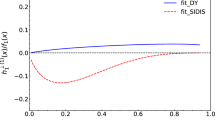Summary
In this paper we calculate the combined angular distribution of the two gamma photons and of the electron in the triple cascade process\(\bar pp \to \psi ' \to \chi _J + \gamma _1 \to (\psi \gamma _2 ) + \gamma _1 \to (e^ + e^ - ) + \gamma _1 + \gamma _2 \) (J = 0, 1, 2), when the protonp and the antiprotonp are both arbitrarily polarized. Our final result is valid in the\(\bar pp\) c.m. frame and it is expressed in terms of the WignerD J functions whose arguments are the angles representing the various directions involved. The coefficients of the terms involving the WignerD J functions are functions of the angular-momentum helicity amplitudes or equivalently of the multipole amplitudes in the radiative processes. They are also functions of the components of the polarization vectors of the proton and of the antiproton in their respective rest frames. We also derive six different partially integrated angular-distribution functions where the combined angulardistribution function of the three particles is integrated over the directions of one or two particles. Our results show that by measuring the angular distribution of single particles, namely γ1, γ2 ande −, alone at a time, we can obtain the relative magnitudes and the relative phases of all the helicity amplitudes in the individual processes,\(\bar pp \to \psi ', \psi ' \to \chi _J + \gamma _1 \) and\(\chi _J \to \psi + \gamma _2 \) for the J=0 and the J=1 cases. For theJ = 2 case, we can get complete information on the helicity amplitudes in the processes\(\bar pp \to \psi '\) and\(\psi ' \to \chi _2 + \gamma _1 \). We can also obtain the relative magnitudes of the helicity amplitudes in the decay process\(\chi _2 \to \psi + \gamma _2 \). In order to obtain the relative phases of these amplitudes uniquely, one has to measure the simultaneous angular distribution of the electron and of γ2.
Similar content being viewed by others
References
Martin A. D. andSpearman T. D., Elementary Particle Theory (North-Holland, Amsterdam) 1970.
Ridener F. L. jr.,Sebastian K. J. andGrotch H.,Phys. Rev. D,45 (1992) 3173.
Olsson M. G. andSuchyta C. J. III,Phys. Rev. D,34 (1986) 2043.
Ridener F. L. jr. andSebastian K. J.,Phys. Rev. D,51 (1995) 1177. At the conclusion of ref. [4] we erroneously claim that we can measure all the cosines and the sines of the relative phases among the helicity amplitudes. I turns out that only the cosines are determined. There are constraint equations on the sines. But they do not fix the sines of the phases unambiguously.
See ref. [1], p. 124.
Ridener F. L. jr. andSebastian K. J.,Phys. Rev. D,49 (1994) 5830.
Karl G., Meshkov S. andRosner J. L.,Phys. Rev. D,13 (1976) 1203.
Author information
Authors and Affiliations
Additional information
The authors of this paper have agreed to not receive the proofs for correction.
Rights and permissions
About this article
Cite this article
Mok, W.A., Sebastian, K.J. Angular distributions in the decays of the ψ’ charmonium state directly produced in polarized proton-antiproton collisions. Il Nuovo Cimento A (1971-1996) 110, 429–455 (1997). https://doi.org/10.1007/BF03035892
Received:
Accepted:
Published:
Issue Date:
DOI: https://doi.org/10.1007/BF03035892




